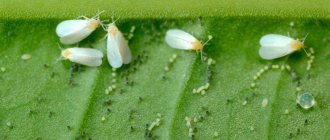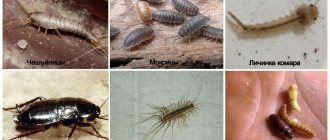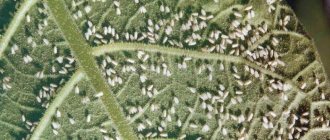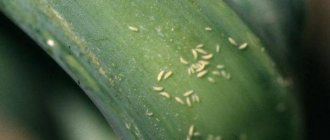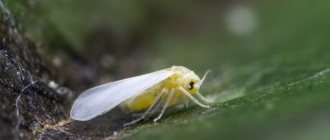Gardeners who grow strawberries know very well how capricious this crop can be. And in order to get a rich harvest of berries with healthy vitamins, you have to make a lot of effort. At the same time, pests cause a lot of trouble, because they also do not mind feasting on the life-giving nectar of plants and fruits.
One of the representatives of the genus of the most harmful insects is the whitefly. Outwardly, these insects resemble white midges. But miniature creatures seem harmless only at first glance; in fact, they pose a serious danger to garden crops.
If white midges appear on strawberries, you need to immediately start fighting them, otherwise the harvest will be lost. These midges cause the most damage to plants. After all, it all ends not only with a noticeable decrease in the yield. A pest attack can lead to the death of the crop.
You need to know the enemy by sight!
Before moving on to ways to combat this miniature pest, it is worth getting to know it better. In Latin, their name is as follows - Aleyrodidae. They belong to representatives of insects with incomplete transformation. However, these pests are characterized by complex development. The size of the whitefly is very small - the length of the body does not exceed 1 millimeter! But due to the fact that insects settle in colonies, they can easily be seen even with the naked eye.
The whitefly survives the winter in grass that has not been harvested since the fall, and with the advent of the first warm days, the insects awaken from a long hibernation and move to the shoots and leaves of plants. And strawberries are an ideal haven for whiteflies.
Attention! For the winter, it is imperative to remove all plant remains from the area, including diseased bushes. You also need to regularly weed and remove weeds.
Only the greatest harm is caused not by adults, but by larvae that live on the underside of strawberry leaves. Their favorite diet is the life-giving juice of garden crops and tender green pulp. For this reason, some time after they settle in, small holes can be noticed on the leaves.
If previously these insects attacked the plants of gardeners in the southern regions, now colonies of pests can settle in the territory of central Russia. The climate here is moderate, with occasional frosts.
The increase in the insect's range is largely determined by the improvement in its ability to hibernate. Some individuals can wait out the cold even in open areas!
White midges are clearly visible on strawberry leaves
Pest prevention
The white midge is an insect that is difficult to get rid of. You can fight it for a long time, which will negatively affect seedlings and harvests. The use of chemicals is not always appropriate, especially if the gardener wants to get an environmentally friendly product. It is better to prevent a problem from occurring than to try to fix it later.
Preventive measures:
- Ventilate the greenhouse regularly even in winter.
- Disinfect structures.
- Keep the area clean - remove plant debris and weeds in a timely manner.
- Constantly dig up the ground.
- Do not store compost in a greenhouse or greenhouse.
The insect is small, but the trouble is big
The danger of whiteflies lies not only in the devouring of strawberries by adults and larvae. Despite their simply huge and insatiable appetite, insects are not able to assimilate all the plant juice they consume, and therefore excrete a special waste product. Visually it looks like dew. And this is simply an ideal environment for the development of a dangerous fungus, which is popularly called mob.
This disease is no less dangerous for garden crops than whitefly. The fungus is able to completely clog the holes in the green part of the plant. This leads to the inevitable cessation of photosynthesis. As a result, the plant withers and dies within a short period of time.
Some gardeners are inclined to believe that flies are found only in open areas. In reality, this opinion is wrong, and whiteflies can be found even in greenhouses. Moreover, greenhouses are an ideal habitat for pests. After all, there is a high level of humidity and constant warmth - what else can you dream of?
Treatment
Before starting therapy, the provoking factor in the development of the pathological condition is determined. If necessary, complex treatment is prescribed:
Medicines
With the help of drugs, the root cause of flickering in front of the visual apparatus is eliminated. The following medications are used for stain removal therapy:
- Wobenzym. The medicine is used in about 5 tablets. The frequency of daily oral administration is 3 times. A course lasting about a month is prescribed.
- Emoxipin. A solution with a 1% concentration is instilled into the organs of vision, 1 drop at a time. The frequency is 5 times a day. The course continues for a month.
- Vitamin complex. Taking the product saturates the body with essential microelements and vitamin compounds. You need to take 1 tablet per day.
After the start of therapy, flickering in front of the organ of vision continues for several days.
Exercises
Elimination of flickering is carried out using special gymnastics of the visual apparatus:
- sit on a chair;
- keep your back straight and move your head up;
- turn your gaze sharply to the right and then to the left;
- move your gaze along the vertical axis;
- repeat movements at short intervals.
Gymnastics allows you to more actively redistribute fluid inside the eyeball and eliminates flickering in front of the visual organs.
Surgical intervention
The pathological condition develops against the background of retinal damage. Then surgical manipulation to remove the flies is necessary. The procedure is carried out in a hospital setting. Reducing the number of spots on the vitreous body involves 2 types of intervention:
- Vitreolysis. Laser fragmentation of opaque zones is carried out in the vitreous body. Manipulation is rarely used; the procedure may result in the development of side effects.
- Vitrectomy. The manipulation is carried out by excision of the vitreous area and filling this area with saline solution. Among the side complications resulting from the manipulation are retinal detachment, cataracts or hemorrhage in the organ of vision.
Just don't give up!
Most experienced gardeners are aware of the danger posed by whiteflies, and therefore try with all their might to combat such a threat. Some use glue traps - a simple method, but not the most effective. The threat from insects is also related to the rate of egg laying. Over a short lifespan (no more than 30 days), the female is capable of laying up to 250 eggs, from which larvae mature within a week.
It will be interesting! The whitefly loves hot and humid conditions, but as soon as the temperature drops to +10 °C, the insects die.
In open ground, reproduction mainly occurs in the summer; in greenhouse conditions, this process can take place all year round. Therefore, a glue trap is not able to completely get rid of insects, and for each missed individual, several hundred new ones soon appear.
For this reason, it is worth using more effective methods:
- chemicals;
- biological agents;
- traditional methods.
The main thing is to give preference only to well-known manufacturers and follow the instructions that come with each drug. It is also worth taking precautions when working with chemical protective equipment.
It is worth considering one feature, due to which pest control should begin as early as possible. Chemicals can only affect adults, while the larvae have strong immunity to any drug.
What are flies and how do they appear?
What we call floaters - moving dark dots, translucent threads, tiny barely visible “tadpoles” that sometimes appear before the eyes - these are tiny opacities What you can do about floaters and flashes in the eye, shadows that the vitreous body of the eye casts on the retina. To figure it out, take a look at the picture.
The vitreous humor is a clear, jelly-like substance that occupies most of the eye. It is thanks to him that the eyeballs have a round shape. On one side, the anterior side, the vitreous body is limited by the lens. From the lateral and posterior sides - the retina.
The vitreous's job is to conduct focused light from the lens to the retina, the light-sensitive cells that capture the resulting image and send it to the brain through the optic nerve.
But here it is important to understand one nuance. The vitreous body, although transparent, is not completely homogeneous
It is woven from the finest collagen fibers, the spaces between which are filled with liquid. Sometimes, due to the natural movement of fibers, so-called lacunae are formed in the spaces - areas where the density of the substance that makes up the vitreous body is reduced. The sensitive retina detects these changes. And we see barely visible glassy “worms”. Something like this:
Other figures - dots, “tadpoles”, flashes of light - are also consequences of the “shadow” that the vitreous body casts on the retina for various reasons. And these reasons can be either completely harmless or dangerous.
Chemistry help
Chemicals should be used when there are large numbers of pests or in cases where more gentle control methods no longer give the desired result. Just keep in mind that due to resistance to a number of drugs, not every type of insecticide is suitable for solving the problem.
Actellik, a contact action product (sprayer), has a good effect. The advantage of this drug is that its active substances do not penetrate into the plant and berries, so there is no danger to the crop itself.
Often they use drugs that have a detrimental effect on the digestive system of insects. To get rid of white midges, use the following means:
- Aktara - the drug is effective for destroying more than 100 varieties of garden pests.
- Rovikurt is an oily liquid against mass destruction of berry crops.
- Pegasus" and Condifor help get rid of the pest if it is detected early.
- Fitoverm, Vertimek are insectoacaricides that have a wide spectrum of action, and insects do not get used to them.
In order to increase the effectiveness of the fight against whitefly, it is worth further strengthening the immunity of plants and increasing their resistance. To do this, insecticide treatment should be combined with the use of a growth stimulator. The drug “Bud” has good qualities.
One of the most effective means of controlling whiteflies on strawberries is chemical treatment.
Signs of infection
It is easy to recognize plant damage by the following external signs:
- yellowing and curling of leaves;
- uneven ripening of fruits;
- discoloration of the internal tissues of tomatoes;
- formation of plaque on the upper leaves;
- presence of insects on the inside of the leaf;
- when you touch the plant, a cloud of midges rises.
What kind of pests could these be?
Many insects can parasitize nightshades. There are two types of midges living on tomatoes: some pests are black in color and are constantly on the move, not inhabiting the plant. Other midges are white and settle on the leaves of seedlings.
The most dangerous pest is the greenhouse whitefly. Her body size is 3 mm. The insect prefers to inhabit the inside of the lower leaves of seedlings, where it lays eggs.
Whiteflies carry viral diseases - leaf curl, chlorosis and jaundice. If measures are not taken in time, this may affect the growth, flowering of the plant, its leaves and fruits.
The moths themselves are not so dangerous - they can be easily eliminated using folk or chemical means. However, it is not so easy to deal with insect larvae - they have protection in the form of a special coating, which reduces the effectiveness of the drugs. In addition, if you use the same products, insects can develop immunity to them.
What harm can they do?
White midges are the most dangerous pests of nightshades. Despite their small size, the damage they cause can be colossal. As soon as midges or their larvae attach to the plant, they begin to consume its sap. Because of this, the seedlings begin to experience a lack of nutrients, which affects their fruits. As a result, the green mass of the plant dries out and falls off, and the fruits wrinkle.
The vital activity of small midges leads to the formation of plaque on the top of the leaf, which can cause it to curl. At first it has a transparent color, which later turns black, indicating the formation of sooty fungi. Parasites appear from insect secretions. They cover the plant stem and fruits.
Rules for processing plants
In order to ruthlessly destroy whiteflies on strawberries by using chemicals, you must adhere to certain rules:
- Strictly follow the dosage prescribed by the manufacturers in the instructions!
- Spraying the crop should be carried out only in dry and windless weather!
- Use different preparations each time so that insects cannot get used to them!
- The process of treating plants should be carried out in the early morning hours or in the evening at sunset! The sun's rays coming into contact with drops containing toxic substances can cause burns.
- With frequent and incorrect use of chemicals, their substances accumulate in the soil. Eating berries collected from cultivated areas is unsafe!
For your information! The pest leaves behind transparent tracks on the back of the leaves, which make it easy to detect. Whiteflies can also be seen upon careful inspection.
You can significantly reduce the population of adult whiteflies and their larvae in your garden in 4 procedures, taking a break of 5 days. Only with each subsequent treatment should the concentration of the drug be reduced. Only compliance with these conditions will allow you to completely get rid of pests and keep the delicacy safe for consumption.
When to see a doctor
In most cases, the appearance of flies is not dangerous to humans. But there are several signs when it is necessary to consult an ophthalmologist:
- flies appear more and more often and their number increases;
- floaters interfere with vision, significantly worsening its quality;
- flies cause significant psycho-emotional discomfort, including manifestations of persistent anxiety and depression;
- there was a head injury, and soon after it these “flying insects” began to appear;
- you have progressive myopia and against this background the number of floaters began to increase.
And now about the most dangerous sign, when you should contact an ophthalmologist urgently: if “lightning sparks” and extensive clouding in the field of vision begin to join the floaters. This may signal a dangerous ophthalmological disorder. For example, when there is a threat of retinal detachment, in many cases the field of vision begins to “spark.” The cause of the sudden appearance of cloudy spots before the eyes is often hemophthalmos - hemorrhage into the vitreous body. Such clouding is usually immediately noticed by the patient, as visual acuity decreases. Inflammation of the uvea (uveitis) is also manifested by loss of transparency of the vitreous body and the appearance of spots in the field of vision.
Features of biological protection
When we fight pests using chemicals, we have to be extremely careful! Inept handling of drugs leads to various consequences. Moreover, not only plants are at risk; the gardener himself is also at risk in a certain sense.
The use of biomaterial is a more gentle solution and an alternative to chemistry. The essence of the biological technique is to intentionally introduce other insects to the garden crop, which will be beneficial by eating whitefly larvae. At the same time, the plants themselves remain safe and sound. Among such saviors we can note the two most common enemies of whiteflies:
- predatory bug Macrolophus;
- parasite of the greenhouse whitefly Encarzia.
Having completed the “cleansing”, the saviors leave the “processing” zone and move to another place. To purchase such biological material, you should contact any large garden farm or laboratory.
The Macrolophus bug is considered a true whitefly killer
Definition
Sometimes, when looking at a bright surface, various structures appear in the eyes in the form of:
- thin threads;
- circles;
- pinpoint and granular accumulations of fibers.
Such small particles prevent the eye from reflecting light and cast small shadows on the retina, whose main function is to perceive color.
This phenomenon is called flying or floating floaters. They occur regardless of age; the causes are determined rather by lifestyle and the individual characteristics of the body.
Black and white floaters are located in the vitreous body, which makes up ⅔ of the volume of the eyeball. The jelly-like liquid inside consists of water and hyaluronic acids, proteins and collagens, performing several functions:
- protection of the eye shell from external irritants;
- maintaining visual acuity;
- ensuring proper functioning of the eye (light refraction, shape support).
This fluid is not replenished and remains for life. However, the prognosis for treatment is favorable.
Folk technique
In addition to specialists, gardeners themselves have been creating their own recipes for pest control for many decades, passing on the knowledge to their children to keep the business alive. And as practice shows, most folk methods are in no way inferior to specialized means of protection in terms of effectiveness. Moreover, they are completely safe for plants and the human body.
Idea! Various lice shampoos or sprays with finpronil will serve as a useful addition to the main means of protection. The shampoo is diluted in water and the leaves are washed with the solution, and the soil around the crop is treated with a spray.
Also, the peculiarity of folk methods is that they help get rid of whiteflies in cases where it is not possible to use chemicals. Basically, all recipes are based on the use of familiar products - onions, garlic, lemon. In other words, there is always a choice:
- If there is a small colony of insects in a small planting, then it is enough to wash the leaves on both sides with warm water, and also loosen the soil near the plants.
- Garlic tincture can repel insects. 100 g of peeled garlic is poured into a liter of water, after which the solution is infused for 7 days. The resulting mixture is filtered and poured into a separate container with a tight lid. For treatment, 10 ml of solution is diluted in a liter of water, and the beds with strawberries are sprayed with it. Treatment is carried out once a week.
- A decoction of lemon peels also has good effectiveness. It’s easy to prepare – use 5 lemons per liter of water. Cook for 60 minutes, after which the solution cools and the leaves of the crop are sprayed with it.
- Laundry soap is an equally effective and fast-acting remedy. Not only plant leaves, but also stems are treated with a soap solution.
- A light bulb next to the plantings. Not a single little midge can resist this trick, which is used by many summer residents. A light bulb turns on next to the crop in the evenings, and its light attracts insects. If they fly close enough, the pests die from the burns they receive. True, this only works with adults.
Moderate planting of seedlings at an optimal distance will help prevent the appearance of pests on strawberry crops - they should not be planted too close to each other, as this will interfere with the natural ventilation of the plants.
If the weather outside is humid, it is better not to water the plants and refuse to spray them. Otherwise, you can create all the conditions for active reproduction of pests
Midges in the country: the most effective means to combat harmful insects
When planting seedlings on his plot, every summer resident dreams of getting a rich harvest. But unfortunately, insect pests often interfere with this: they gnaw the roots, spoil the fruits and suck out the nutritious juices from the plants. Such parasites include the midge, and despite its small size, it can quite seriously damage both seedlings and those crops that have already gained growth. So, let's figure out why midges are dangerous in the country, and what ways you can get rid of them.
Preventive actions
No wonder there is a popular wisdom: the best defense is an attack. Therefore, any lover of garden crops interested in growing strawberries and other berries needs to prepare in advance for the upcoming attack from natural profit lovers.
It is optimal to place onion or garlic plantings between the rows - they emit a pungent and unpleasant odor for insects, which will avoid this place. True aesthetes should take a closer look at marigolds and nasturtiums. Small parasites also cannot stand the smell of these flowers.
Important! Since the damage from the miniature pest is very great, it is necessary to carefully inspect the young bush before planting it for the presence of uninvited guests. The main reason for the mass death of plantings is the acquisition of an infected seedling/
A similar effect can be achieved by using wood ash. To repel pests, you should scatter it near the bushes. In addition, it is useful to give the culture a hot shower every month. The water is heated to 80 °C, and the plants are watered from a watering can.
Floaters fly before your eyes: diagnosis of the disease
- From all of the above, it is obvious that we see colorless flies flying before our eyes for many reasons. Sometimes we see black spots before our eyes due to eye fatigue, and sometimes due to the presence of serious diseases in the body.
- Before you begin treatment and elimination of such an unpleasant symptom as floaters before your eyes, you need to establish the disease that provoked it.
- The first thing you need to do is contact an ophthalmologist and tell him your complaints.
- The specialist will collect anamnesis, analyze complaints and refer you to the necessary examinations that will help you understand what exactly caused the spots before your eyes.
The following examinations may be prescribed:
- Ultrasound of the eye.
- Ophthalmoscopy. With the help of such an examination, the specialist will be able to see empty cavities and opacities in the vitreous body.
Needs to be examined
- Visometry. This procedure makes it clear how well a person sees in principle.
- Tanometry is the measurement of intracranial pressure.
- By decision of the doctor, the patient may be referred for other examinations depending on the complaints.
Why are they dangerous?
Like many indoor insects, flower midges are not dangerous to humans. Midges will not bite or transmit dangerous infections. However, in addition to the unpleasant sensations from such a neighborhood, small parasites cause moral damage by destroying flower plants that purify the air and create comfort in the house.
Small gray-black flies lay large numbers of eggs in moist soil. They hatch into voracious white worms that eat the roots of the flowers. The plant begins to wither. Young plantings with an undeveloped root system die faster. You can save your “green friend” if you come to the rescue in time, before all the roots of the flower are affected. It is necessary to transplant the plant into a pot with high-quality soil, first remove the oviposition.
The presence of midges is not a reason for despair. Perhaps the parasites did not have time to settle in the pot. It’s easy to verify this: you need to dig up the ground next to the plant. No larvae found? This means that there remains a real chance of saving the flower. After all, fighting insects is much easier than fighting their “children.”
Chemicals
If there is an abundance of insects, treatment of the area against midges is carried out with chemicals. These can be both organic insecticides and mild pesticides. To spray bushes and soil, you can use the following preparations:
Important! Rain significantly reduces the effectiveness of many insecticides!
Chemicals are very successful in controlling midges on both seedlings and adult plants. However, in order for the treatment to give the desired result, it is necessary to spray the entire bush, including the back side of the leaves, because, as you know, this is where the bulk of the parasites are concentrated. In addition, do not forget that you will have to use the insecticidal solution two to three times at intervals of a week. All instructions and application details can be found in the instructions.
Important! If treatment against midges is carried out in closed ground conditions, then after it it is advisable to cover the greenhouse with thick fabric to create shade.
“Bazudin” copes well with larvae parasitizing in the soil. This product is used as follows: remove the top layer of soil around each bush, pour in granules of the drug and cover them with earth. With each watering, the active substances will penetrate the substrate and destroy pests.
How to detect whiteflies in the garden
The whitefly resembles a midge. If you shake the seedlings, a whole cloud of small butterflies should fly off. In addition, on the inside there will be small capsules - parasite larvae. Over time, damaged plants become covered with white dew - these are waste products of insects.
Sometimes black spots appear on the leaves of plants. This is the action of a fungus that grows in the secretions of whiteflies. This small butterfly is popularly called an aphid. You can treat plants against parasites using natural remedies or buy chemicals.
It’s difficult to say which means are better and how to treat cabbage against whiteflies. You need to go through the options until one works 100%. If you do nothing about insects, you will be left without a harvest this year.


